The Future of Greenhouses: Technologies in Sustainable Agriculture
Are you curious regarding the future of greenhouses and just how they are reinventing lasting agriculture? Look no more! In this short article, we will check out the exciting developments that are leading the way for a greener and extra efficient farming market. From sophisticated environment control systems to upright farming strategies, water-efficient watering methods, eco-friendly energy combination, and smart information analytics, these advancements are changing the method we grow our food. Prepare yourself to uncover the future of lasting farming in greenhouses!
Advanced Environment Control Solution
To attain optimum growing conditions, you can count on the improvements in greenhouses with advanced environment control systems. These systems have transformed the way we grow plants, giving a regulated setting that contributes to plant development. With these ingenious systems, you can currently manipulate temperature level, moisture, light degrees, and even CO2 focus to produce the excellent conditions for your plants to thrive.
Among the crucial features of these advanced environment control systems is their capability to manage temperature. By utilizing sensing units and automated controls, the greenhouse can change the temperature level based upon the specific needs of the plants. This ensures that they are never ever subjected to extreme warm or cold, which can be damaging to their growth.
Moisture control is one more essential element of these systems. By maintaining the ideal humidity degrees, you can prevent issues such as mold, mildew, and condition from affecting your plants. These systems can also regulate the amount of light that gets to the plants, making certain that they obtain the optimal quantity for photosynthesis.
Furthermore, progressed climate control systems can also adjust carbon dioxide concentrations. By enhancing the degrees of CO2 in the greenhouse, you can enhance plant growth and performance. This is specifically helpful in locations with low all-natural carbon dioxide levels.
Upright Farming Strategies
One crucial vertical farming technique is making use of stacked growing systems. Monarch Decorative Greenhouse Utah. These systems involve preparing plants in numerous layers, up and down piled on top of each various other. By utilizing upright space, farmers can optimize their plant yield without calling for added land. Piled expanding systems are typically utilized in urban areas where space is limited.
One preferred approach is recognized as upright hydroponics, where plants are grown in nutrient-rich water without dirt. This technique is extremely efficient as it lowers water usage by approximately 90% compared to typical farming methods. Additionally, because the plants are grown inside, they are shielded from illness and parasites, lowering the need for pesticides.
One more strategy is aeroponics, which entails putting on hold the plant roots in a mist or air atmosphere. This method allows for optimum nutrient absorption and oxygenation, leading to faster growth and higher yields. Aeroponics likewise utilizes much less water than traditional farming and can be carried out in upright systems, making it a popular option for upright farming.
Water-efficient Watering Methods
Taking full advantage of water conservation is essential when it involves carrying out water-efficient watering methods in lasting farming. With international water shortage ending up being a pushing concern, it is critical to establish cutting-edge techniques that maximize water usage in greenhouse procedures.
One promising method is drip watering, which supplies water straight to the plant origins, minimizing waste and dissipation. By utilizing a network of tubes with tiny emitters, water is applied gradually and precisely, making sure that plants obtain the essential wetness without excess drainage.
Another effective strategy is making use of soil dampness sensing units. These tools measure the dampness content in the dirt and offer real-time information to farmers. By monitoring the dirt's moisture levels, farmers can accurately establish when and just how much water to use, preventing over-irrigation.
Moreover, the implementation of rainwater harvesting systems is gaining popularity in greenhouse farming. Gathering rainwater from roofs and saving it in storage tanks allows farmers to utilize this natural source for watering objectives, decreasing reliance on conventional water sources.
Finally, the adoption of automated watering systems can substantially enhance water efficiency. These systems make use of other sensing units to detect dirt moisture levels and weather, adjusting irrigation schedules accordingly. By enhancing water usage based on real plant demands, these systems can reduce water waste and promote sustainable farming methods.
Renewable Resource Combination
Renewable energy integration in greenhouses offers numerous benefits, consisting of reduced running costs and reduced dependence on non-renewable power sources. The generated power can then be used to run numerous operations within the greenhouse, such as ventilation, lighting, and home heating systems. These wind turbines harness wind power and transform it into power, which can be used to supplement the energy demands of the greenhouse.
Smart Data Analytics and Automation
To boost the effectiveness of your greenhouse operations and optimize source utilization, think about executing smart data analytics and automation. Smart information check it out analytics includes accumulating and assessing data from different sensing units and tools within your greenhouse.
This can include automating the control of lighting, air flow, irrigation systems, and nutrient delivery. By automating these processes, you can make sure that your plants receive the best problems and nutrients at the best time, without the need for constant hand-operated treatment.
Moreover, clever information analytics and automation can work with each other synergistically. The information collected by sensing units can Website be used to inform computerized systems, allowing them to make real-time modifications based upon the current conditions. This integration of information analytics and automation can lead to much more effective and specific source appropriation, inevitably causing greater returns and much better crop high quality.
Conclusion
In final thought, the future of greenhouses in lasting agriculture looks appealing. With sophisticated climate control systems, vertical farming methods, water-efficient irrigation techniques, and renewable energy assimilation, greenhouses are coming to be much more efficient and environmentally pleasant.

By maximizing water use based on real plant needs, these systems can lower water waste and advertise lasting farming practices.
